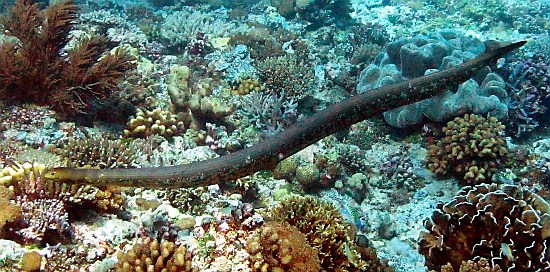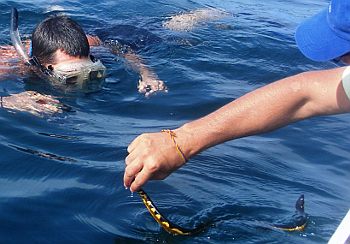SICB Annual Meeting 2012
January 3-7, 2012
Charleston, SC
Symposium: New Frontiers from Marine Snakes to Marine Ecosytems

An olive seasnake (Aipysurus leavis) swims over part of the Great Barrier Reef in Australia. Photograph courtesy of Vimoksalehi Lukoschek
Summary: This Symposium is intended to highlight new and current research on marine snakes including associated ecological systems and conceptual issues. The session is timely due to a current renaissance of research in which new investigators will be participants into the foreseeable future. The symposium will be structured with an associated Workshop (see below) and is intended to be forward-looking with focus on breadth of timely issues. The speakers will bring a diverse group of current investigators in terms of age, gender, topic, and international representation.
Associated Workshop: “Building Conceptual Bridges between Marine Snake Research and Challenging Frontiers in Biology.”
Goals of the Symposium and Workshop: There are several interrelated goals, which are summarized as follows.
- Bring together world’s experts who currently investigate the biology of marine snakes and their interactions with marine ecosystems in which they live. The fundamental purpose is to promote interactions and exchange of ideas in relation to the other goals which follow.
- Establish and promote the use of marine systems as models for investigating current leading issues related to environment, changing climate, and persistence of biological communities, with focus on marine snakes as model examples. This is important because studies are needed for tropical systems, and the majority of sea snakes occur on coral reefs which are in crisis in context of these issues.
- Identify leading-edge topics for which studies of marine snakes might contribute to advancement of understanding.
- Summarize and evaluate the current states of knowledge for various topics in a context of moving fields forward and promoting linkages to ongoing research.
- Build collaborations among the various persons who will participate in, and attend, the Symposium and Workshop.
Conceptual foci:
- Understanding Terrestrial-to-Marine Evolutionary Transitions.
- Bridging Ecology and the Physiology of Water Balance.
- Evolutionary Physiology.
- Phylogeography, Evolution and Species Diversification.
- Biodiversity and Conservation.
Sponsors:
- NSF

- SICB Divisions: DAB, DCPB, DNB, DPCB (formerly DSEB), DVM
- University of Florida

- Vida Preciosa International, Inc.

- Gourmet Rodent, Inc.

- Sable Systems International

Organizers
- Harvey B. Lillywhite, University of Florida, Gainesville, FL
- Francois Brischoux, CEBC-CNRS, Villiers en Bois, France
Speakers

Joe Pfaller readies to photograph a Yellow-bellied sea snake (Pelamis platurus) being released by Coleman Sheehy III into Pacific waters off the coast of Costa Rica. Photograph courtesy of Harvey B. Lillywhite
S5-1.0 Thursday, Jan. 5, 08:00 Lillywhite, HB:
Introduction to the Symposium
S5-1.1 Thursday, Jan. 5, 08:05 MURPHY, John:
Marine Invasions by Non-Sea Snakes, With Thoughts on Terrestrial-Aquatic-Marine Transitions
S5-1.2 Thursday, Jan. 5, 08:30 VORIS, Harold K.:
How a Dynamic Climate and Landscape in Southeast Asia During the Neogene Directed the Evolution and Diversification of Marine Snakes
S5-1.3 Thursday, Jan. 5, 09:00 LILLYWHITE, HB*; BRISCHOUX, F; SHEEHY III, CM; PFALLER, JB:
Dehydration and Freshwater Drinking Requirements of Marine Snakes
S5-1.4 Thursday, Jan. 5, 09:30 BRISCHOUX, F*; TINGLEY, R; SHINE, R; LILLYWHITE, HB:
Distributional data helps to identify evolutionary challenges: Oceanic salinity as a major constraint during the transition to marine life in snakes
S5-1.5 Thursday, Jan. 5, 10:30 BABONIS, L.S.*; BRISCHOUX, F.:
Perspectives on salt gland evolution in marine snakes
S5-1.6 Thursday, Jan. 5, 11:00 HEATWOLE, Harold*; GRECH, Alana; MONAHAN, John; KING, Sue; MARSH, Helene:
Ectothermy in the marine environment: new perspectives from the ecology and geography of sea snakes
S5-1.7 Thursday, Jan. 5, 11:30 TU, Ming-Chung*; LIU, Yu-Ling:
New perspectives on the extent of terrestriality in three species of sea kraits and their habitat selection
S5-2.1 Thursday, Jan. 5, 13:00 BONNET, X:
Long term field study of sea kraits in New Caledonia: fundamental and conservation issues
S5-2.2 Thursday, Jan. 5, 13:30 PFALLER, Joseph B.*; FRICK, Michael G.; BRISCHOUX, Francois E. O.; SHEEHY III, Coleman M.; LILLYWHITE, Harvey B.:
Ecology of Epibiosis: What Can We Learn From Marine Reptiles
S5-2.3 Thursday, Jan. 5, 14:00 SANDERS, K L*; RASMUSSEN, A R; DE SILVA, A; MUMPUNI, n/a; UKUWELA, D B:
Ecological innovation and speciation in viviparous sea snakes (Hydrophiinae)
S5-2.4 Thursday, Jan. 5, 14:30 SHEEHY III, C.M.*; LILLYWHITE, H.B.; PFALLER, J.B.:
Low genetic diversity across the Pacific Ocean in the pelagic sea snake, Pelamis platurus
______________________________
William Dunson will present a historical plenary lecture at a dinner to follow the symposium session.

Catherine Michel and Denis Serin record morphometric data from a Blue-banded sea krait (Laticauda laticaudata) at Amere Island in the Reserve Integrale Merlet, in the South-East Lagoon of New Caledonia. Photograph courtesy of Xavier Bonnet.

